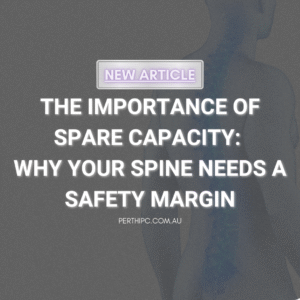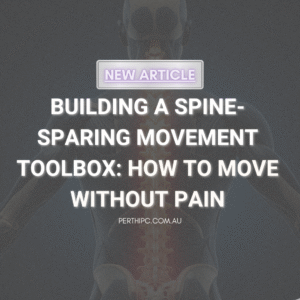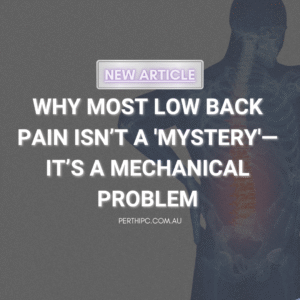
The Importance Of Spare Capacity – Why Your Spine Needs A Safety Margin
What if your back pain isn’t just from one bad movement — but from constantly living on the edge of your spine’s limits? This is


Proximal hamstring tendinopathy (previously called hamstring tendinitis) is a condition that affects the tendons that attach the hamstring muscles to the pelvis. It is a common injury among athletes, particularly those who participate in sports that involve running and jumping such as hurdles, sprinting, and sports that involve changing direction activities such as football, and hockey. However, it can also occur in people who have a sedentary lifestyle and do not participate in sport.
Tendinopathy is an umbrella term used to describe clinical conditions associated with overload in and around tendons. There are two types of tendinopathy: acute and chronic. Acute tendinopathy is caused by a sudden injury, such as sprain or strain. Chronic tendinopathy on the other hand, is caused by repetitive stress on the tendon over time. To learn more about Tendinopathy, read our “WHAT IS TENDINOPATHY” blog post HERE.
It is characterised by deep, localised pain in the region of the ischial tuberosity, or the sit bones. Pain is usually worse during or after activities such as squatting, lunging, running, or even sitting.
The hamstrings muscle group is one of the most important muscle groups in running. The hamstrings consist of three muscles: semitendinosus, semimembranosus, and biceps femoris. They are active throughout multiple stages in the gait cycle, particularly knee flexion and hip extension. The hamstring muscles share a common origin on the lateral aspect of the ischial tuberosity. Semitendinosus and the long head of biceps femoris share a conjoined tendon that originates from the lateral facet. Semimembranosus has an origin that is much deeper.
In proximal hamstring tendinopathy, the semimembranosus is one of the most commonly affected hamstring muscle. However, proximal hamstring tendinopathy can occur in various other locations such as biceps femoris, semitendinosus, and the common hamstring tendon.
Proximal hamstring tendinopathy affects the junction between the tendons of the hamstrings and the ischial tuberosity. Due to the tendon’s fibrousness, thickness, and poor blood supply, healing can be difficult.
Tendinopathy has a range of contributing factors, however, these factors are usually load related. An example of an extrinsic factor is a training error such as an increase in training intensity and/or volume too quickly. This type of activity requires the hamstring to contract or lengthen when the hip is in flexion, which can lead to a higher tensile and compression load at the tendon insertion. Another cause may be excessive static stretching such as in yoga or Pilates. This type of activity involves sustained end hip flexion postures. Long periods of sitting can also cause symptoms.
The key to tendinopathy management and rehabilitation is to use load management. Progressive loading, performed within a pain-monitoring framework, reduces pain and ultimately restores function.
The following rehabilitation process can be used to treat proximal hamstring tendinopathy. It involves four stages of exercise prescription and can take 3-6 months to complete. Every patient is treated individually so exercise prescriptions and time frames are specific to that person. However, in general, the following should apply:
Stage 1: Isometric hamstring load
Isometric exercises in positions without tendon compression loads the muscle-tendon unit and reduces pain. Symptom severity is used to determine the dosage of isometric exercises, which should be completed several times per day.
In the early stages of proximal hamstring tendinopathy, the position of the hip should be nearly neutral or in minimal hip flexion. An immediate reduction in pain with hamstring loading tests after exercise is a favourable sign for isometric hamstring loading. The following exercises are often used in this stage:
Stage 2: Isotonic hamstring load with minimal hip flexion
Isotonic hamstring loading can be started when there is minimal or no pain during hamstring loading in early ranges of hip flexion. Heavy Slow Resistance (HSR) training includes eccentric and concentric elements and has been shown to have positive effects in tendinopathy rehabilitation.
The aim of HSR is to perform a slow fatiguing isotonic exercise. Loaded hip flexion should be minimised in the early stages to protect the enthesis against too much compression. It is important to focus on single-leg work to address asymmetrical strength loss. Stage 1 isometric exercises can be completed on the “off” days of stage 2 isotonic exercise to help with pain management if symptoms are still present.
The following exercises are often used in this stage:
Stage 3: isotonic exercises in increased hip flexion (70° – 90°)
The aim of rehabilitation in this stage is to continue with hamstring strengthening, muscle hypertrophy, and functional training all in greater hip flexion. Once there is minimal or no pain with higher loading hip flexion tests, isotonic strengthening in increased hip flexion can be implemented.
Technique is important and exercises should be performed slow and controlled. The progression into greater hip flexion often causes pain, so it is important to monitor the 24 hour response post exercise.
The following exercises are often used in this stage:
Stage 4: Energy storage loading
This stage is only necessary for those returning to sports that involve lower limb energy storage or impact loading. When there is minimal or no pain during load tests, power/elastic stimulus for the myotendinous unit can be introduced. It is essential to have good movement control and adequate bilateral strength in single leg exercises completed in stage 2 and 3. In the early phase of stage 4, hip flexion should be limited to protect the proximal hamstring tendon from compression.
The following exercises are often used in this stage:
Returning to sports can be gradually introduced when the athlete is able to cope with the loading requirements of the sport with minimal symptom aggravation, which includes minimal pain during and any pain settling within 24 hours. In team sports, a more detailed assessment is often required with a graded exposure to activity prior to return to full competition.
Adjunct treatment methods include:
To prevent proximal hamstring tendinopathy, it is important to maintain good strength and ‘health of tissues’ in the muscles and tendons of the thigh. Increasing capacity of the tendon to ensure it can tolerate the activity, exercises or sport demands you are placing on the tissue.
It is also important to avoid overuse and to gradually increase the intensity of physical activity. If you spike to volume and intensity of the load placed on the tendon too quickly, you can place yourself at higher risk of developing tendon issues – so ensure you progress your loading demands in a controlled and appropriate manner. You should aim for no more than a 10% increase in total volume or intensity over a week period.
In conclusion, proximal hamstring tendinopathy is a common condition that affects the tendons that attach the hamstring muscles to the pelvis. It is characterized by pain and tenderness in the back of the thigh, and can be caused by overuse or a sedentary lifestyle. Treatment options include physical therapy, rest and ice, and medication. In more severe cases, surgery may be necessary. To prevent proximal hamstring tendinopathy, it is important to maintain good flexibility and strength in the muscles and tendons of the thigh, and to avoid overuse.

What if your back pain isn’t just from one bad movement — but from constantly living on the edge of your spine’s limits? This is

One of the most overlooked causes of persistent low back pain is how we move during everyday tasks. Simple activities like bending, sitting, getting out of a car, or

If you’ve been told your back pain is “non-specific” or has “no clear cause,” you’re not alone. Up to 85% of people with low back